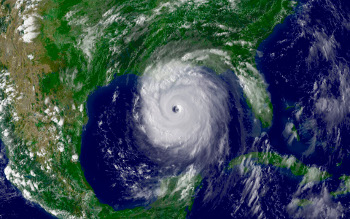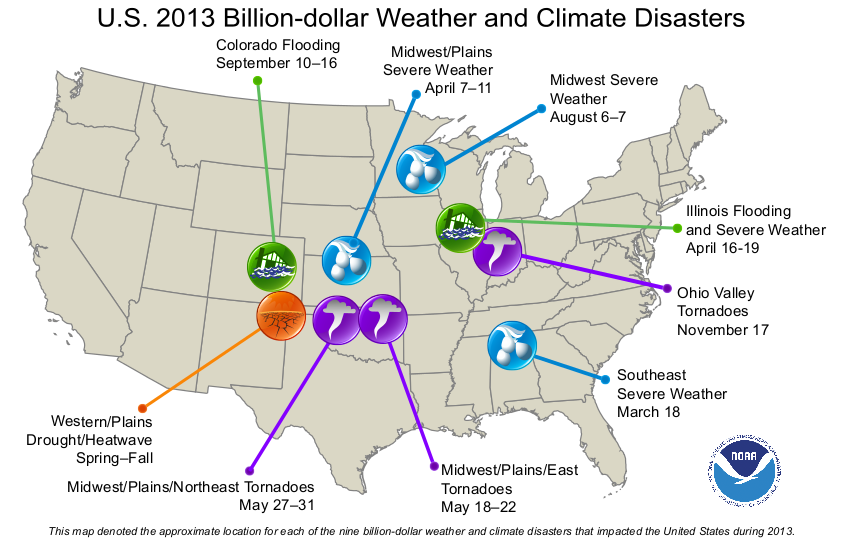Billion-Dollar Weather/Climate Disasters: Overview
The National Climatic Data Center (NCDC) is the Nation's Scorekeeper in terms of addressing severe weather/climate events in their historical perspective. As part of its responsibility of monitoring and assessing the climate, NCDC tracks and evaluates climate events in the U.S. and globally that have great economic and societal impacts. NCDC is frequently called upon to provide summaries of global and U.S. temperature and precipitation trends, extremes, and comparisons in their historical perspective. Found here are the weather/climate events that have had the greatest economic impact from 1980 to 2013. The U.S. has sustained 170 weather/climate disasters since 1980 where overall damages/costs reached or exceeded $1 billion (including CPI adjustment to 2013). The total cost of these 170 events exceeds $1 trillion.
2013 in Context
In 2013, there were 9 weather/climate disaster events with losses exceeding $1 billion each across the United States. These events included a drought event, 2 flooding events, and 6 severe storm events. Overall, these events resulted in the deaths of 113 people and had significant economic effects on the areas impacted.
Methodology and Data Sources
In 2012, NOAA's National Climatic Data Center reviewed its methodology on how NCDC develops Billion-dollar Disasters. NCDC held a workshop with economic experts (May, 2012) and worked with a consulting partner to examine possible inaccuracy and biases in the data sources and methodology used in developing the loss assessments (mid-2013). This ensures more consistency with the numbers NCDC provides on a yearly basis and give more confidence in the year-to-year comparison of information. Another outcome is a published peer-reviewed article "U.S. Billion-dollar Weather and Climate Disasters: Data Sources, Trends, Accuracy and Biases". This research article found the net effect of all biases appears to be an underestimation of average loss. In particular, it is shown that the factor approach can result in an underestimation of average loss of approximately 10–15%. This bias was corrected during a reanalysis of the loss data to reflect new loss totals.
It is also known that the uncertainty of loss estimates differ by disaster event type reflecting the quality and completeness of the data sources used in our loss estimation. In 2013, three of the nine billion-dollar events (i.e., the drought and two flooding events) have higher potential uncertainty values around the loss estimates due to less coverage of insured assets. The remaining 6 events (i.e., severe local storms) have lower potential uncertainty surrounding their estimate due to more complete insurance coverage. To that end, we have temporarily rounded our loss estimates to the nearest billion dollars while developing research to define uncertainty and confidence intervals surrounding these estimates.
In performing these disaster cost assessments these statistics were taken from a wide variety of sources and represent, to the best of our ability, the estimated total costs of these events -- that is, the costs in terms of dollars that would not have been incurred had the event not taken place. Insured and uninsured losses are included in damage estimates. Sources include the National Weather Service, the Federal Emergency Management Agency, U.S. Department of Agriculture, other U.S. government agencies, individual state emergency management agencies, state and regional climate centers, media reports, and insurance industry estimates.
References
- Smith, A., and R. Katz, 2013: U.S. Billion-dollar Weather and Climate Disasters: Data Sources, Trends, Accuracy and Biases. Natural Hazards.
DOI: 10.1007/s11069-013-0566-5 - Lott, N., and T. Ross, 2006: Tracking and evaluating U. S. billion dollar weather disasters, 1980-2005. Preprints. AMS Forum: Environmental Risk and Impacts on Society: Successes and Challenges, Atlanta, GA, Amer. Meteor. Soc., 1.2.
- Lott, N., and T. Ross, 2003: A Climatology of 1980-2003 Extreme Weather and Climate Events, Technical Report.

